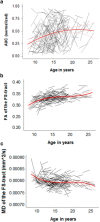Frontostriatal White Matter Integrity Predicts Development of Delay of Gratification: A Longitudinal Study
- PMID: 26865618
- PMCID: PMC6602010
- DOI: 10.1523/JNEUROSCI.3459-15.2016
Frontostriatal White Matter Integrity Predicts Development of Delay of Gratification: A Longitudinal Study
Abstract
The ability to delay gratification increases considerably across development. Here, we test the hypothesis that this impulse control capacity is driven by increased maturation of frontostriatal circuitry using a fiber-tracking approach combined with longitudinal imaging. In total, 192 healthy volunteers between 8 and 26 years underwent diffusion tensor imaging scanning and completed a delay-discounting task twice, separated by a 2-year interval. We investigated dynamic associations between frontostriatal white matter (WM) integrity and delay of gratification skills. Moreover, we examined the predictive value of frontostriatal WM integrity for future delay of gratification skills. Results showed that delay discounting increases with age in a quadratic fashion, with greatest patience during late adolescence. Data also indicated nonlinear development of frontostriatal WM, with relative fast development during childhood and early adulthood and--on average--little change during mid-adolescence. Furthermore, the positive association between age and delay discounting was further increased in individuals with higher WM integrity of the frontostriatal tracts. Predictive analysis showed that frontostriatal WM development explained unique variance in current and future delay of gratification skills. This study adds to a descriptive relation between WM integrity and delay of gratification by showing that maturation of frontostriatal connectivity predicts changes in delay of gratification skills. These findings have implications for studies examining deviances in impulse control by showing that the developmental path between striatum and prefrontal cortex may be an important predictor for when development goes astray.
Significance statement: During the transition from childhood to adulthood, individuals generally show increased patience and become better in delaying gratification. The exact neural correlates of delay of gratification, however, remain poorly understood. By measuring both frontostriatal white matter (WM) integrity and delay of gratification skills at two time points, we were able to provide links for our understanding of the neural mechanisms underlying this type of impulse regulation capacity. We demonstrate that the ability to delay gratification improves between childhood and young adulthood and this improvement is predicted by the integrity of frontostriatal WM connections. This study adds to a descriptive relation between WM quality and delay of gratification by showing that maturation of frontostriatal connectivity predicts improvements in delay of gratification skills.
Keywords: adolescence; development; impulsivity; longitudinal; white matter.
Copyright © 2016 the authors 0270-6474/16/361954-08$15.00/0.
Figures




References
-
- Akaike H. New look at statistical-model identification. IEEE Trans Automat Contr Ac. 1974;19:716–723. doi: 10.1109/TAC.1974.1100705. - DOI
Publication types
MeSH terms
LinkOut - more resources
Full Text Sources
Other Literature Sources
